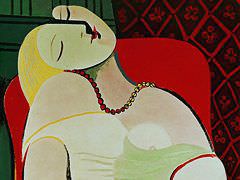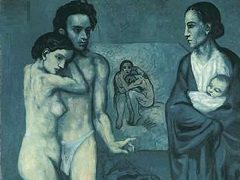Still-Life with Chair Caning, 1912 by Pablo Picasso

At first glance, Picasso's Still-Life with Chair Caning of 1912 might seem a mish-mash of forms instead of clear picture. But we can understand the image - and other like it - by breaking down Cubist pictorial language into parts. Let's start at the upper right: almost at the edge of the canvas (at two o'clock) there is the handle of a knife. Follow it to the left to find the blade. The knife cuts a piece of citrus fruit. You can make out the rind and the segments of the slice at the bottom right corner of the blade.
Below the fruit, which is probably a lemon, is the white, scalloped edge of a napkin. To the left of these things and standing vertically in the top center of the canvas (twelve o'clock) is a wine glass. It's hard to see at first, so look carefully. Just at the top edge of the chair caning is the glass's base, above it is the stem (thicker than you might expect), and then the bowl of the glass. It is difficult to find the forms you would expect because Picasso depicts the glass from more than one angle. At eleven o'clock is the famous "JOU," which means "game" in French, but also the first three letters of the French word for newspaper (or more literally, "daily"; journal=daily). In fact, you can make out the bulk of the folded paper quite clearly. Don't be confused by the pipe that lays across the newspaper. Do you see its stem and bowl?
Beginning in 1908, and continuing through the first few months of 1912, Georges Braque and Picasso co-invent the first phase of Cubism. Since it is dominated by the analysis of form, this first stage is usually referred to as Analytic Cubism. But then during the summer of 1912, Braque leaves Paris to take a holiday in Provence. During his time there, he wanders into a hardware store, and there he finds a roll of oil cloth. Oil cloth is an early version of contact paper, the vinyl adhesive used to line the shelves or drawers in a cupboard. Then, as now, these materials come in a variety of pre-printed patterns.
Braque purchased some oil cloth printed with a fake wood grain. That particular pattern drew his attention because he was at work on a Cubist drawing of a guitar, and he was about to render the grain of the wood in pencil. Instead, he cut the oil cloth and pasted a piece of the factory-printed grain pattern right into his drawing.
Picasso was not far behind Braque. Picasso immediately begins to create collage with oil cloth as well - and adds other elements to the mix (but remember, it was really Braque who introduced collage - he never gets enough credit). One of the keys to understanding the importance of Cubism, of Picasso and Braque, is to consider their actions and how unusual they were for the time. When Braque, and then Picasso placed industrially-produced objects ("low" commercial culture) into the realm of fine art ("high" culture), they acted as artistic iconoclasts (icon=image/clast=destroyer).
With this collage, Picasso and Braque changed the direction of art for generations to come.
















